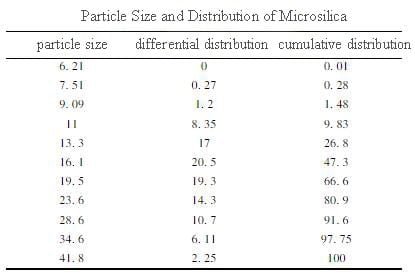Characteristics of silica fume:
- 1. The microsilica is a kind of neutral inorganic filler with stable physical properties and chemical properties. It does not contain crystalline water, does not participate in the curing reaction and does not affect the reaction mechanism.
- 2. It has good wettability to all kinds of resins, good adsorption properties, easy mixing and no agglomeration.
- 3. The particle size distribution of micro silica fume is reasonable, the density is strong, the hardness is great, and the wear resistance is good. It can greatly improve the tensile, compressive, impact strength and wear resistance of the solidified material, and the punching resistance can be increased by 0.5 to 2.5 times.
- 4. It can increase the thermal conductivity, change the tackiness and increase the flame retardancy.
- 5. It can reduce the exothermic peak temperature of the curing reaction of epoxy resin, reduce the linear expansion coefficient and the shrinkage of the solidified substance, thus eliminate the internal stress and prevent the cracking.
- 6, as the fine particle size and reasonable distribution, micro silica fume powder can effectively reduce and eliminate precipitation and stratification.
- 7, the silica fume is pure, the impurity content is low, the physical and chemical properties are stable, so that the condensates have good insulation and arc resistance.
- 8, the chemical composition of microsilica is silicon dioxide (SiO2), which is inert, and does not react with most of the acid and alkali. The silica fume is evenly distributed and covered on the surface of the object. It has strong corrosion resistance and the ability to resist cavitation is 3 to 16 times.
- 9, the bulk density is small: As polymer filled materials, it is less expensive than other mineral filling materials, with less loading capacity and less polymer consumption, thus reducing the cost of products.
- 10, frost resistance: by circulating 300 to 500 times quickly, the relative elastic modulus increases 10 – 20%, while the ordinary concrete through 25 to 50 cycles, and the relative elastic modulus reduce 30 to 73%. Therefore, the frost resistance of concrete can be improved.
- 11, early strength: micro silica fume concrete has shortened the induction period and has the characteristics of early strength.
Use of microsilica in concrete:
Silica fume can be fully dispersed and filled in the gap between the cement particles, making the slurry more dense, the volcanic ash activity index of the micro silica powder can reach 110, the effective substitution coefficient reaches 3-4. There is strong absorption force to the Ca (OH) 2 produced after the hydration of cement, forming a well developed calcium silicate gel, which is greatly developed, improve the strength of concrete.
1, increase strength: when the mixing amount is 5-10%, the compressive strength of concrete can be increased by 10-50%, and the flexural strength will be increased by more than 10%.
2, increase density: when mixed with 10%, the impermeability increased by 5-8 times, and the resistance to carbonization increased by more than 4 times.
3, increase the frost resistance: the concrete mixed with 10% micro silicon powder decreases the relative dynamic elastic modulus by 1-2% after 300-500 times of freezing and thawing cycle, and the relative dynamic elastic modulus has been reduced by 36-73% after the ordinary concrete is circulate for 25-50 times.
4, increase early strength.
5, increase abrasion resistance and cavitation resistance: micro silica fume concrete can increase 0.5-2.5 times of abrasion resistance and increase cavitation resistance by 3-16 times. It is the best material for hydropower station, reservoir and dams to wear and repair.




